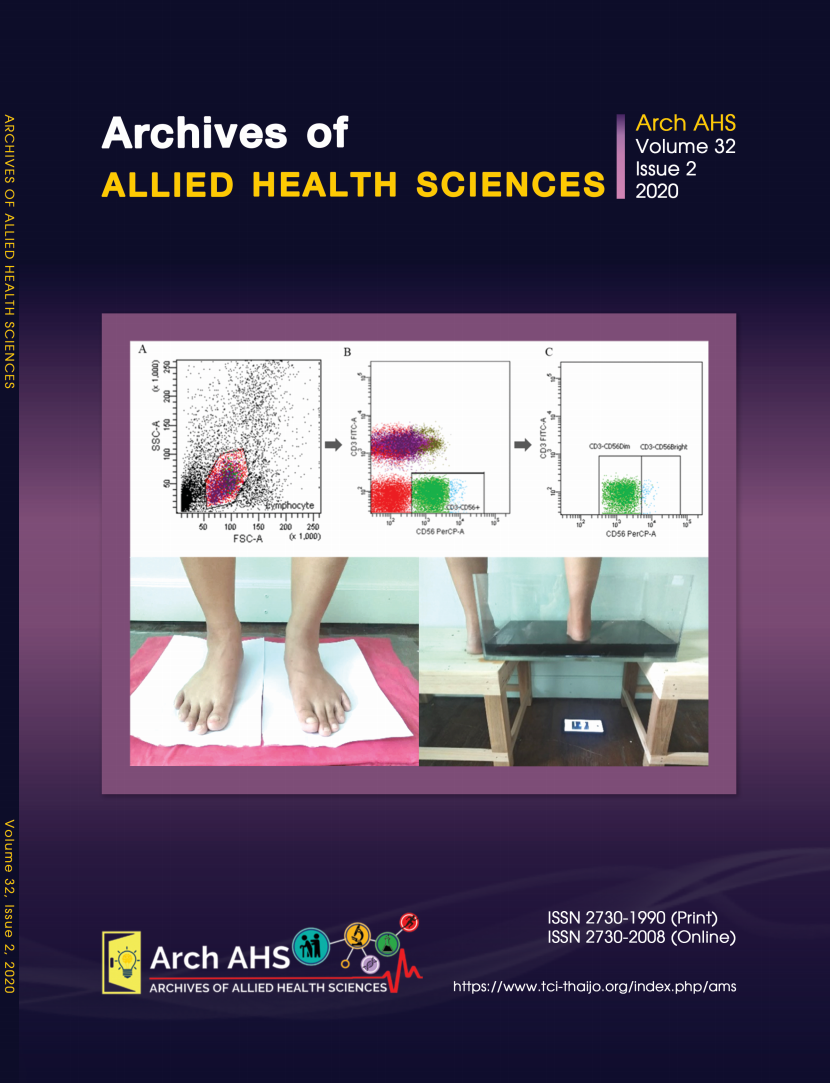Alteration of natural killer cell subset proportion is associated with risk factors of coronary artery disease in aging
Main Article Content
Abstract
Currently, the world population is moving to aging society because of decreasing fertility rates and increasing survival in old age. In Thailand, the results of the National Statistics Office showed that the number and proportion of older people increase continuously. Age-related impairment of human immunity involves in many chronic inflammatory diseases such as coronary artery disease (CAD). Thus, age is one of the risk factors for CAD causing the chronic inflammation condition. Natural killer (NK) cell is one of the immune cells that change in aging. Thus, this study aims to investigate the alteration of NK cells and NK cell subsets in aging and their association with the risk factor of CAD. Blood samples from aging (≥ 60 years old) group and who had any risk factors for CAD, were collected. Additionally, blood samples of young group (age < 35 years old) without risk factors associated with CAD were included. Whole blood from these samples were stained with anti-CD3 and anti-CD56 labeled with FITC and PerCP, respectively to determine NK cell subsets by flow cytometry technique. The result showed that the proportion of NK cell subsets (CD56bright/CD56dim) was significantly decreased in aging (p-value < 0.001) and also tended to decrease in aging who had more than or equal to 2 CAD risk factors when compared with aging who had less than 2 CAD risk factors (p-value = 0.051). Thus, this result suggested that alteration of NK cell subsets in aging was associated with the risk factor of CAD and this might be the marker for CAD that needs to be investigated further.
Article Details

This work is licensed under a Creative Commons Attribution-NonCommercial-NoDerivatives 4.0 International License.
References
United Nations. Department of Economic and Social Affairs. Population Division. World population ageing, 1950-2050. New York: United Nations; 2002; p. 483.
National statistical office. The 2014 survey of the older persons in Thailand. Bangkok.
Larbi A, Franceschi C, Mazzatti D, Solana R, Wikby A, Pawelec G. Aging of the immune system as a prognostic factor for human longevity. Physiol J 2008; 23: 64-74.
Myers CE, Mirza NN, Lustgarten J. Immunity, cancer and aging: lessons from mouse models. Aging Dis 2011; 2(6): 512-23.
Ezzati M, Riboli E. Behavioral and dietary risk factors for noncommunicable diseases. N Engl J Med 2013; 369(10): 954-64.
Mendis S, Davis S, Norrving B. Organizational update: the world health organization globalstatus report on noncommunicable diseases 2014; one more landmark step in the combatagainst stroke and vascular disease. Stroke 2015; 46(5): e121-2.
World Health Organization. Prevention of cardiovascular disease : guidelines forassessment and management of cardiovascularrisk. Geneva: World Health Organization; 2007. p. 86.
Mathers C, Fat DM, Boerma JT, World Health Organization. The global burden of disease : 2004 update. Geneva, Switzerland: World Health Organization; 2008. p. 146.
World Health Organization. Global status report on noncommunicable diseases. Geneva,Switzerland: World Health Organization.
Cooper MA, Fehniger TA, Caligiuri MA. The biology of human natural killer-cell subsets. Trends Immunol 2001; 22(11): 633-40.
Chidrawar SM, Khan N, Chan YL, Nayak L, Moss PA. Ageing is associated with a decline in peripheral blood CD56bright NK cells. Immun Ageing 2006; 3: 10.
Jabir NR, Firoz CK, Ahmed F, Kamal MA, Hindawi S, Damanhouri GA, et al. Reduction in CD16/CD56 and CD16/CD3/CD56 Natural Killer Cells in Coronary Artery Disease. Immunol Invest 2017; 46(5): 526-35.
Backteman K, Ernerudh J, Jonasson L. Natural killer (NK) cell deficit in coronary artery disease: no aberrations in phenotype but sustained reduction of NK cells is associated with low-grade inflammation. Clin Exp Immunol 2014; 175(1): 104-12.
Kubota K, Shirakura T, Orui T, Muratani M, Maki T, Tamura J, et al. Changes in the blood cell counts with aging. Nihon Ronen Igakkai Zasshi 1991; 28(4): 509-14.
Chatta GS, Andrews RG, Rodger E, Schrag M, Hammond WP, Dale DC. Hematopoietic progenitors and aging: alterations in granulocytic precursors and responsiveness to recombinant human G-CSF, GM-CSF, and IL-3. J Gerontol 1993; 48(5): M207-12.
Suwannatrai A, Saichua P, Haswell M. Epidemiology of Opisthorchis viverrini Infection. Adv Parasitol 2018; 101: 41-67.
Valiathan R, Ashman M, Asthana D. Effects of Ageing on the Immune System: Infants to Elderly. Scand J Immunol 2016; 83(4): 255-66.
Almeida-Oliveira A, Smith-Carvalho M, Porto LC, Cardoso-Oliveira J, Ribeiro Ados S, Falcao RR, et al. Age-related changes in natural killer cell receptors from childhood through old age. Hum Immunol 2011; 72(4): 319-29.


